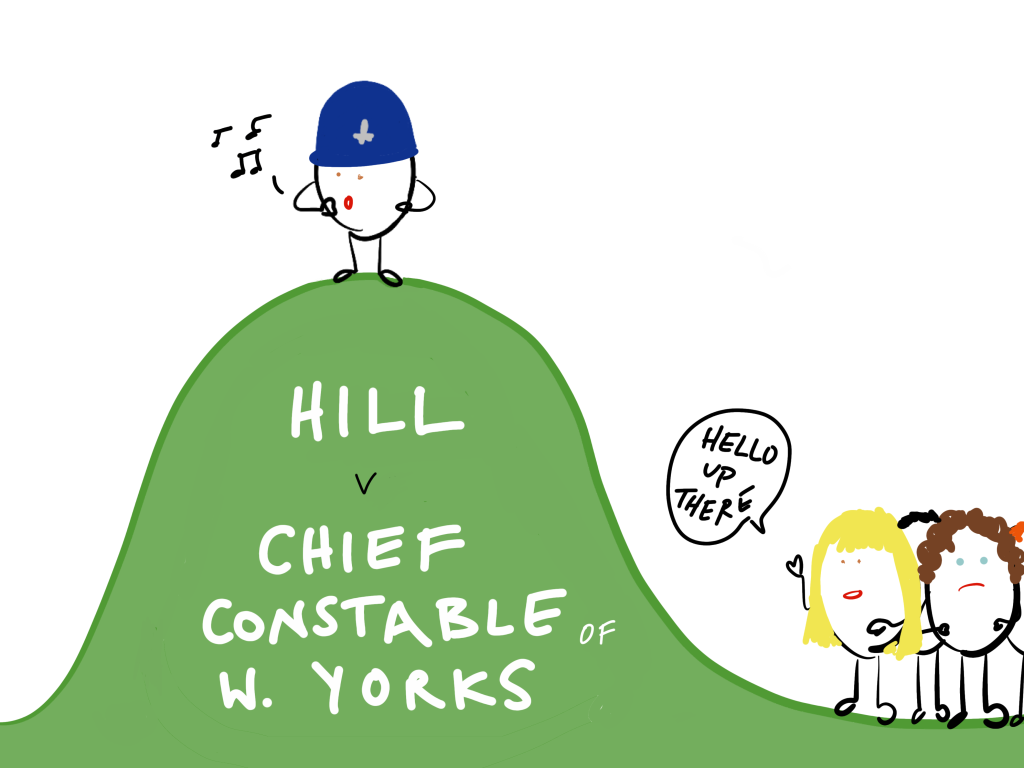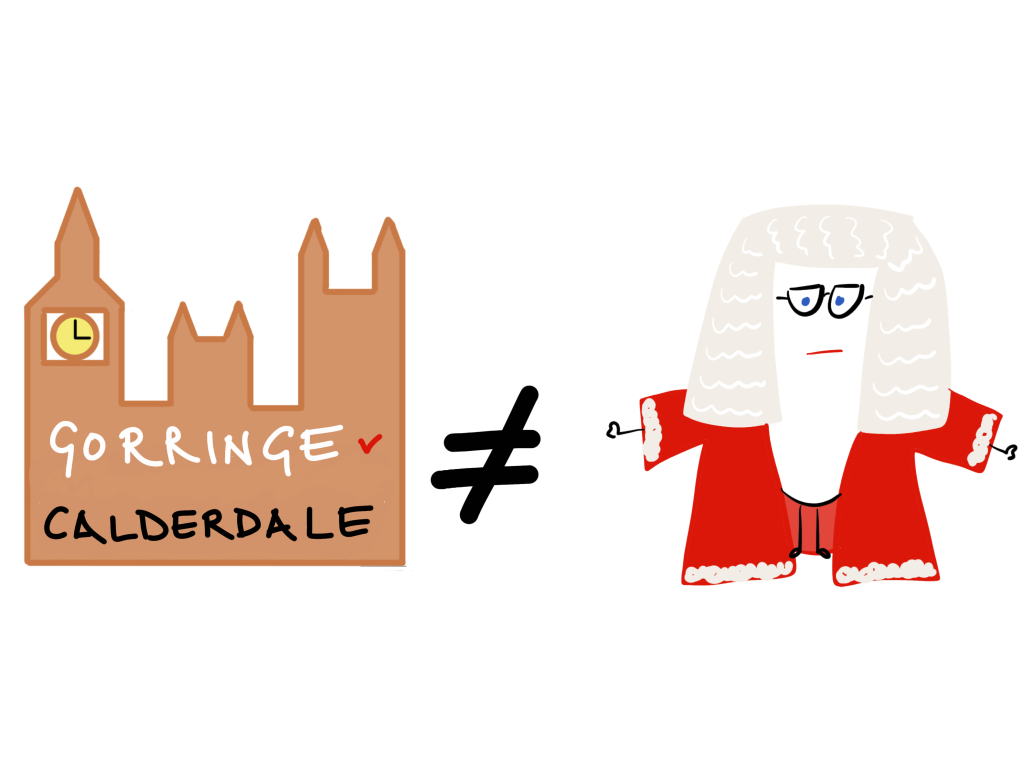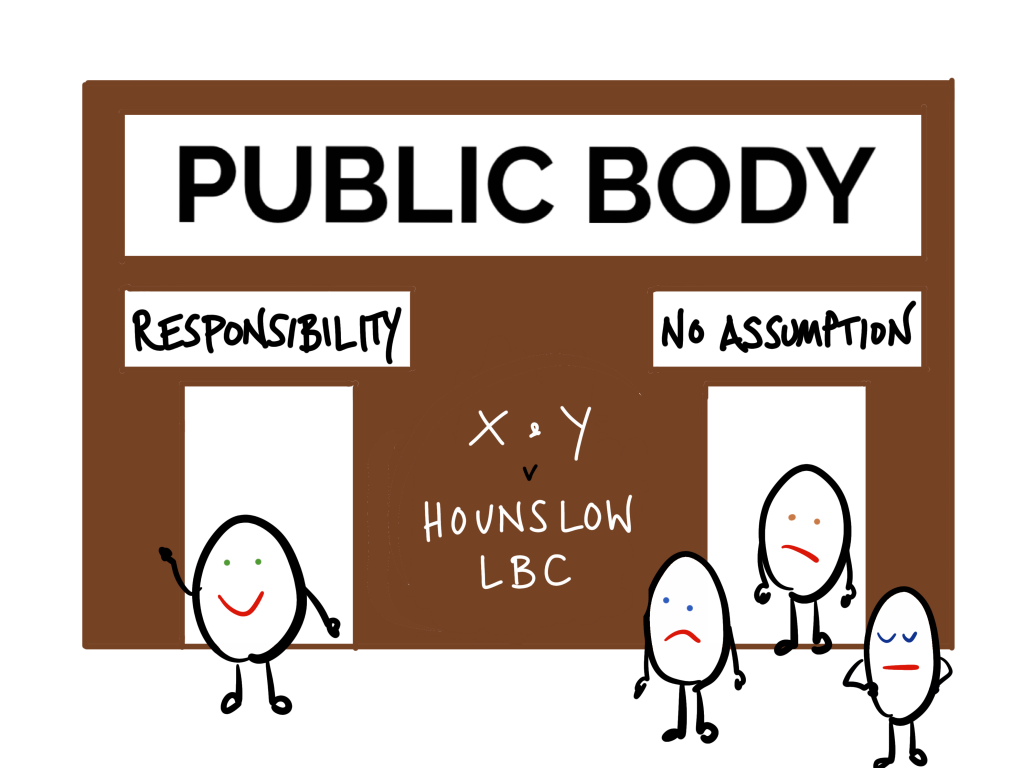JUMP TO: PUBLIC BODIES | BLANKET IMMUNITY? | JUSTICIABILITY | ASSUMPTION OF RESPONSIBILITY | CLAIMS UNDER HRA 1998 | INFORMANTS | EMERGENCY SERVICES | AMBULANCE SERVICE | ARMED FORCES | REVISE | TEST
PUBLIC BODY DUTY OF CARE
In the past the courts have often appeared disinclined to find public bodies liable for negligence, basing their decisions on reasons of public policy such as not wanting to encourage defensive practices or place too heavy a burden on public resources. However, the modern position on public body duty of care was set out in Robinson v Chief Constable of West Yorkshire Police (2018) (SC).
Public bodies should be dealt with in exactly the same way as private individuals but not all acts or omissions of public bodies are justiciable.
An elderly woman was knocked over by two police officers as they attempted to arrest a drug dealer. They were found liable for her injuries as it was reasonably foreseeable that the police officers’ actions would cause the claimant harm, based on the neighbour principle from Donoghue v Stevenson (1932) (HoL). The Supreme Court did not overturn any previous case law but stated the position the court should adopt when considering whether a public body owes a duty of care to an individual.
PUBLIC BODIES
When considering the existence of a duty of care owed by a public body he court should note that public bodies are subject to the same liabilities in negligence as any private individual and should not be dealt with in a different manner. This is, unless a duty is excluded by legislation under which that public body operates.

Emphasis was placed on the distinction between situations in which the defendant caused the harm (such as Robinson v Chief Constable of West Yorkshire Police (2018) (SC)) which should be dealt with following the standard approach for finding a duty of care and ones in which the defendant failed to confer the benefit of protection from harm upon the claimant (caused either by themselves or others). In the latter case the same rules surrounding omissions and the acts of third parties apply to public bodies as they would to any private individual (see General Duty of Care).
An example of the public body causing the harm is Rigby v Chief Constable of Northamptonshire (1985) (HC). The police released CS gas canisters into a shop that was under siege without taking any precautions against the risk of fire. A fire did break out and the owner of the shop successfully sued the police for negligence.
The scope of this duty of care to confer the benefit of protection from harm on the claimant extends to a duty to take reasonable care not to provide misleading information which may foreseeably cause physical injury. A good example of this is Darnley v Croydon Health Services NHS Trust (2018) (SC). The claimant suffered a head injury. At A&E he was given incorrect information by an A&E receptionist about waiting times. Believing that he would have to wait 5 hours he left the hospital without seeing a doctor about his head injury. When his condition worsened later that day he was taken to hospital but suffered permanent brain damage. The hospital owed him a duty of care which they had breached.
BLANKET IMMUNITY?
Pre-Robinson, in situations in which harm had been caused by a public body’s failure to act, decisions had tended towards the idea that most public bodies were almost automatically free from liability because of public policy considerations. For example, the leading case of Hill v Chief Constable of West Yorkshire (1989) (HoL).

The mother of the Yorkshire Ripper’s last victim sued the police for failing to arrest the killer before he murdered her daughter. He had been caught and interviewed by the police but then let go. The court held that there was insufficient proximity between the police and any woman who might have been a victim. They could not owe a duty of care to all potential victims. There was also an emphasis on public policy considerations; if the police could be found negligent for decisions made during an investigation they might begin implementing defensive practices to avoid future law suits. Also time spent defending legal claims was a waste of police time and money when their most important priority was fighting crime and keeping the public safe.
In Robinson v Chief Constable of West Yorkshire Police (2018) (SC) Lord Reed stated that Hill, although correctly decided, had been subsequently misunderstood as a decision based purely on public policy considerations. Whatever they may have been, fundamentally the police did not owe a duty of care to the victim based on the standard rules of liability. They were not liable for the actions of a third party and there had been no specific assumption of responsibility between them and the victim or the murderer. The consideration of public policy was unnecessary. Robsinson was therefore a restating of what the ratio from Hill should have been as opposed to what it was subsequently understood to be.
The apparent ‘blanket immunity’ enjoyed by the police had been criticised before by the ECHR in Osman v UK (1999) as a breach of Article 6 (Right to a Fair Trial). However, in Z v UK (2001) the court admitted that it did not understand English tort law and that the ‘immunity’ enjoyed by the police did not limit a claimant’s right to a fair trial.
JUSTICIABILITY
A statutory power does not create an automatic common law duty of care, not all acts or omissions by public bodies are justiciable (Gorringe v Calderdale Metropolitan Borough Council (2004) (HoL)).

The claimant had been injured in a car accident and tried to sue the local council for not painting a Slow Down sign on the road to improve traffic safety. The case was unsuccessful. Lord Hoffman in the leading judgment said that he found it difficult to imagine a case in which a common law duty could be founded simply on the failure to provide some benefit which a public authority had the power (or a public law duty) to provide. However, he did distinguish this from cases in which a public body did acts or entered into relationships or undertook responsibilities that could give rise to a duty of care on an orthodox common law foundation.
PUBLIC POLICY
Issues of public policy and the difficulties for public bodies in exercising discretionary powers can still be taken into consideration by the courts. This can be done when the court is considering extending an existing liability by asking ‘would the extension be just and reasonable?’ Or, the court can consider whether the legislation under which the public body operates excludes or restricts the duty of care that they may owe to a claimant.
ASSUMPTION OF RESPONSIBILITY
POSITIVE ACTS
If the claimant’s harm was caused by a positive, negligent act of the defendant then it will be easier to find an assumption of responsibility for the claimant. The court must then establish whether it was reasonably foreseeable that their act would cause harm to the claimant.
A good example of a public body causing the harm is Rigby v Chief Constable of Northamptonshire (1985) (HC) in which the police released CS gas canisters into a shop that was under siege without taking any precautions against the risk of fire. A fire did break out and the owner of the shop successfully sued the police for negligence.
Another example is Robinson v Chief Constable of West Yorkshire Police (2018) (SC); the claimant had been knocked down by police officers.
OMISSIONS & ACTS OF THIRD PARTIES
As for private individuals public bodies will not generally owe a duty of care for omissions or the acts of third parties. However, the same exceptions apply as for private individuals (see General Duty of Care page).
It can be difficult to find that the defendant assumption of responsibility specifically for the claimant, especially when the defendant may only owe a statutory duty. The cases below illustrate this well.

In X & Y v Hounslow London Borough Council (2009) (CoA) X & Y were a married couple, both with mild learning difficulties. They were recognised by the council as vulnerable adults in need of support in the community. Their social worker became aware that their flat was being used by local youths as a place for storing stolen goods, drug taking and under age sex. She reported it to the council’s Children and Families Section and requested that their application for re-housing be accelerated. Before this happened the couple, and Y’s two children, were subjected to a weekend of physical and psychological abuse by the local youths. The claim against the council for failing to rehouse the claimants was unsuccessful, the failure to act could not be the basis for a claim as the council had never specifically assumed responsibility for the couple. They had statutory duties under the National Assistance Act 1948 for the welfare of the handicapped but this did not mean that they owed a common law duty of care. The only person who had assumed responsibility and could have owed them a duty of care was the Social Worker but her behaviour had been exemplary and she therefore would not have been in breach. The council were merely fulfilling their statutory duty, no more and no less.
Another example is Poole Borough Council v GN (2019) (SC). GN were two children who had been housed, with their mother, in a council house next door to people known to engage in anti-social behaviour. The family was harassed by their neighbours leading to the children suffering physical and psychological harm. However, the court held that there was no duty of care owed because the council had never assumed responsibility for the children. Their role in monitoring the situation and investigating the risk posed by the neighbours was not a specific service on which the family could reasonably have relied, nor had the family specifically entrusted their safety to the council or been taken into care.
In contrast consider the case of Barrett v Enfield London Borough Council (2001). Barrett had been in care since the age of 10 months. The council had failed to find him adoptive or foster parents or organise a meting with his biological mother. The court held that, although only assumed because of a statutory duty, the council had assumed a parental responsibility for the claimant. In Phelps v Hillingdon Borough Council (2001). The defendant had employed an educational physiologist to assess the needs of the claimant. Their assessment had been negligent and failed to diagnose the claimant as dyslexic. As a result her educational development and employment prospects were affected. The court held that the council was vicariously liable; the psychologist had impliedly undertaken to exercise proper professional skill in diagnosis thereby assuming responsibility.
Also consider cases such as Costello v Chief Constable of Northumberland (1999) (CoA), Palmer v Tees Health Authority (1999) (HoL) and Mitchell v Glasgow City Council (2009) (HoL) outlined in the General Duty of Care section that involve public bodies and their assumption of responsibility.
CLAIMS UNDER HUMAN RIGHTS ACT 1998
Claims against public bodies have also been brought under the Human Rights Act 1998. For example, in Osman v UK (1999) (which began life as Osman v Ferguson (1993) (CoA)) a breach of Article 2 (Right to Life) was argued.
Osman had been murdered, and his son badly injured, by his son’s teacher (Paget-Lewis) who had subjected the family to a sustained campaign of harassment, including crashing a car into their house, smearing their house with excrement, assaulting one of the son’s friends and verbally abusing the son in public. Despite reports to the police and Paget-Lewis admitting criminal insanity and stating he might murder people he was never cautioned. The court found that Article 2 rights had not been breached because there had not been ‘a real and immediate risk to the life of an identified individual or individuals from the criminal acts of a third party’.

‘A real and immediate risk to life’ is a high hurdle to overcome. In Van Colle v Chief Constable of Hertfordshire Police (2008) (HoL) Van Colle had been receiving threatening messages from an ex-employee, Brougham, who had been charged with theft from Van Colle’s business. The messages were designed to get Van Colle to drop the charges. Van Colle reported these to the police. Before Van Colle could testify against him he was shot dead by Brougham. His family brought a claim against the police under Article 2 arguing that they had failed in their duty to take measures to avoid the risk of a real and immediate risk to the life of an identified individual. The court held that the behaviour of the murderer had not satisfied this requirement; there was no decisive moment when the police should have been aware of an imminent threat to life.
DISSENTING JUDGMENTS
Even with the decision in Robinson and the removal of any imagined public policy immunity for public bodies many cases involving injury by a third party would still have been decided against the claimant for lack of proximity or assumption of responsibility. However, there have been several judges who have made dissenting judgments calling for an avenue for victims who have warned the police about their assailant.
In Smith v Chief Constable of Sussex Police (2008) (CoA) Smith was brutally attacked by his ex-boyfriend suffering skull fractures, brain damage and psychological injury. Prior to the attack he had been receiving multiple texts and emails every day threatening him with violence and death. Smith informed the police but no statement was taken and no crime report was filed. When he recontacted the police to tell them about further threats the police office refused to look at them and told him the case was progressing. Even though he argued that he was a known potential victim of his assailant, and more identifiable than the victim in Hill, his claim failed for the public policy reasons as set out in Hill v Chief Constable of West Yorkshire (1989) (HoL), his claim failed for the public policy reasons as set out in Hill (see General Duty of Care page).
Lord Bingham dissented and set out his theory of a Liability Principle; if a member of the public gives the police credible evidence that a third party presents a specific and imminent threat to his/her life or physical safety the police should owe them a duty of care. This principle has not been taken up by courts.
In the case of Michael v Chief Constable of South Wales (2015) (SC) a woman was killed by her ex-boyfriend. She had rung 999 when her ex had arrived at her house, bitten her ear and taken away her current boyfriend shouting ‘I’m going to drop him home and …[fucking kill you]’. The emergency caller claimed that she heard ‘hit’ and not ‘kill’. Based on this the call was downgraded from top priority and the police were not sent immediately. Before they could arrive he had come back and stabbed her to death. The negligence claim failed for lack of proximity and public policy reasons. Lord Kerr and Lady Hale dissented, setting out that sufficient proximity should be found where; information is communicated to the defendant that serious harm is likely to befall the intended victim if urgent action is not taken and the defendant might reasonably be expected to provide protection without unnecessary danger to themselves.
These attempts have so far been rejected by the courts for various reasons; public policy grounds, not needing or wanting to go further than the Human Rights Act and the difficulty in setting a test in these circumstances.
It has been established that there is a duty of care owed between the police and their informants (Swinney v Chief Constable of Northumbria (No 2) (1999) (CoA)).

Swinney became a police informant when she gave information to the police about the killing of a policeman. She was promised that her name would be kept secret. A document containing her details was stolen from the police. Scared of the consequences the informant suffered psychiatric illness and sued the police. The court held that the police did have a duty of care for an informant, there was sufficient proximity and they had specifically assumed responsibility for her safety. However, in this case the duty had not been breached by the theft of the information.
In An Informer v A Chief Constable (2012) (CoA) a claim for pure economic loss suffered by an informant was not upheld. The duty owed by the police was limited to physical injury.
EMERGENCY SERVICES
There is no general duty for the emergency services to attend an emergency. They owe a general duty to the public but not to specific individuals (Alexandrou v Oxford (1993) (CoA)).

Alexandrou owned a shop. One evening the alarm went off which activated a call to the police. When they arrived to inspect the property they failed to notice the burglars hiding at the back of the shop. The court held that there was no duty of care owed to an individual who alerted the police to a crime and this was true of automated alarms as well.
This extends to the fire brigade. There is no general duty to attend an emergency. However, if the emergency services do attend an emergency then a duty of care arises not to make the situation worse by any action taken (Capital and Counties v Hampshire County Council (1997) (CoA)).

The Hampshire fire brigade was called to a fire in a building. When they arrived the officer in charge ordered that the sprinklers were turned off, thereby allowing the fire to spread more easily. The fire brigade were held liable because they had made the situation worse.
The same principle also covers the coastguard. They owe no duty of care to rescue individuals at risk but if they do intervene then they owe a duty of care not to make things worse (OLL v Secretary of State for Transport (1997) (HC)).
AMBULANCE SERVICE
The ambulance service is an extension of the NHS, which does owe a general duty of care to its patients, and therefore it is not the same as other emergency services. Acceptance of a 999 call does establish a duty of care to respond and to respond without carelessness (Kent v Griffiths (2001) (CoA)).

An ambulance took so long to arrive, with no good reason, that a pregnant woman lost her child and suffered psychiatric illness. The ambulance service owed her a duty of care to arrive in a reasonable time.
However, if an ambulance’s delay is due to a policy consideration (i.e. deciding to transfer resources to a more critical case) then there may not be a duty of care.
ARMED FORCES
In general the armed forces will only owe a duty of care to its solders if they have assumed responsibility for an individual in a specific, non-combat situation but will not necessarily owe a duty of care in combat situations.

NON-COMBAT
In Barrett v Ministry of Defence (1995) (CoA) a very drunk naval pilot died when he choked on his own vomit. The officer in charge was held to have assumed responsibility for him when he ordered someone to put him to bed and breached that duty by not having someone watch over him through the night.
The same occurred in Jebson v Ministry of Defence (2000) (CoA); a solider was injured when drunkenly attempting to climb onto the roof of the army vehicle that was transporting him back to base. The army owed him a duty of care to provide suitable transport and provisions for its soldiers after an evening off base.
|
COMBAT
However, this duty of care does not extend to combat circumstances. In Mulcahy v Ministry of Defence (1996) (CoA) a soldier shot by friendly fire was not owed a duty of care because the injury had been sustained during combat. It would go against common sense and public policy to allow claims for negligence that had happened during battle conditions.
In Smith v Ministry of Defence (2013) (SC) the court held that what constitutes combat should be defined very narrowly. In this case the procurement of vehicles unsuitable for combat was deemed outside the scope of active combat.
|


































